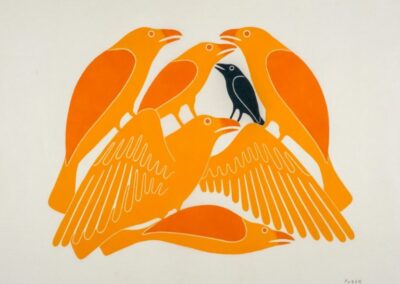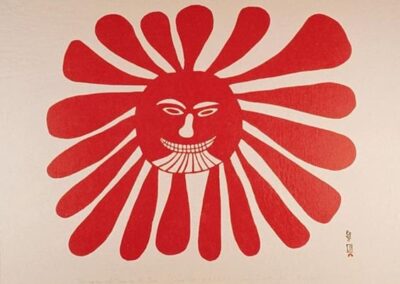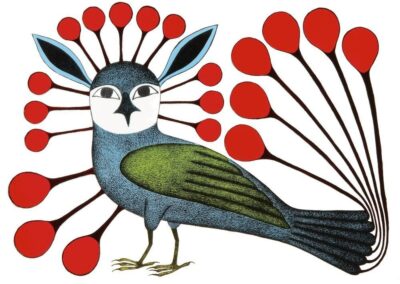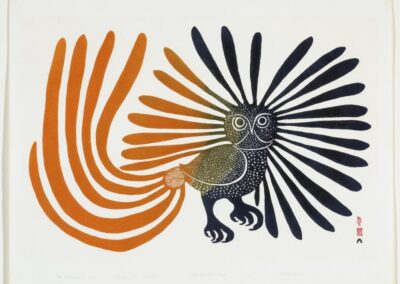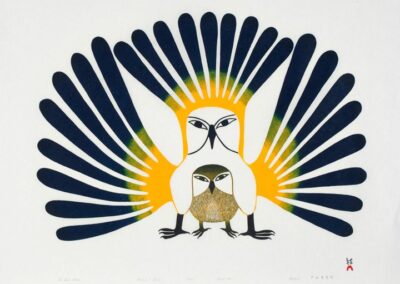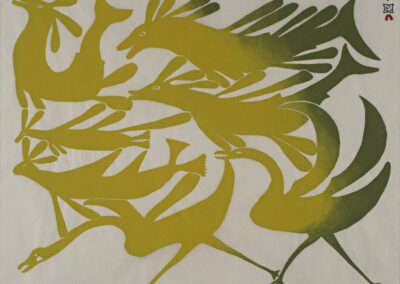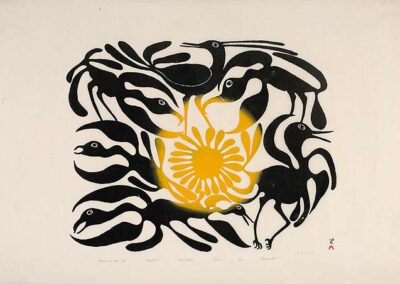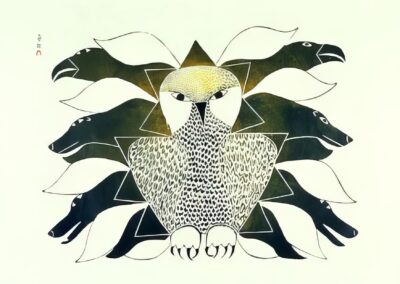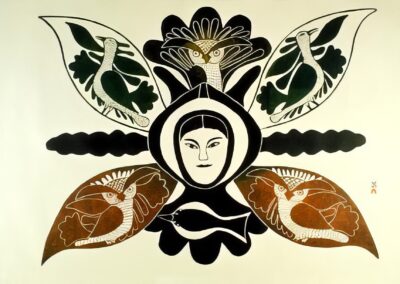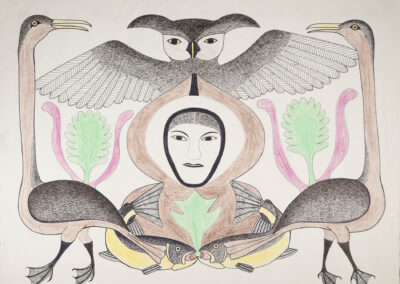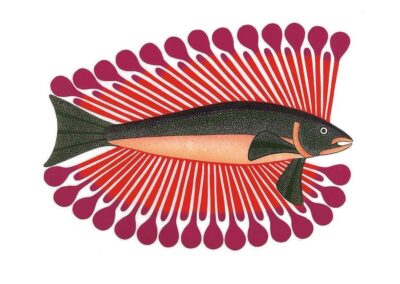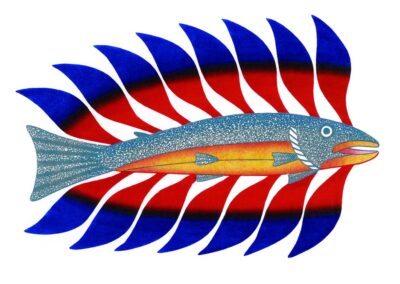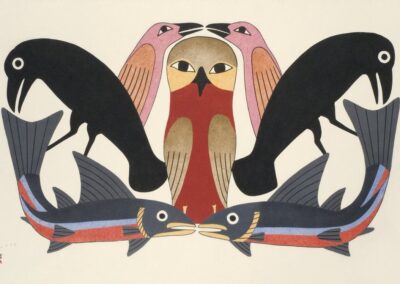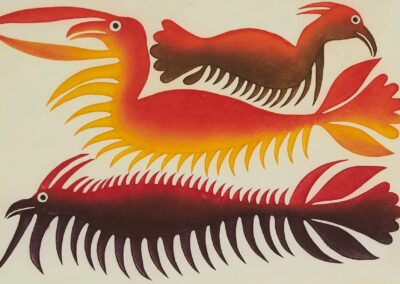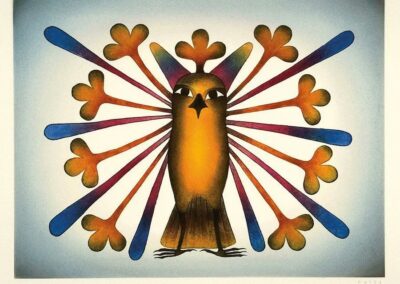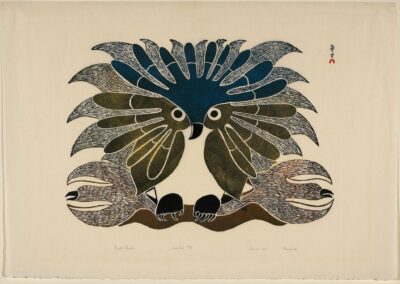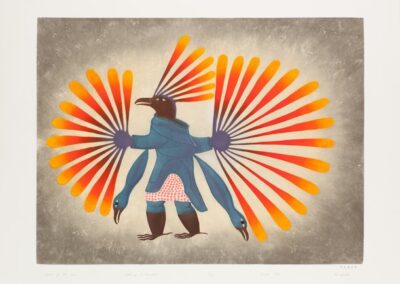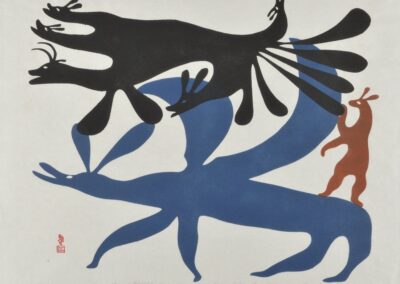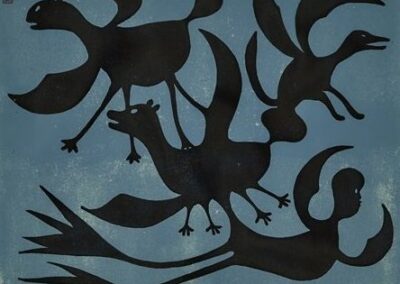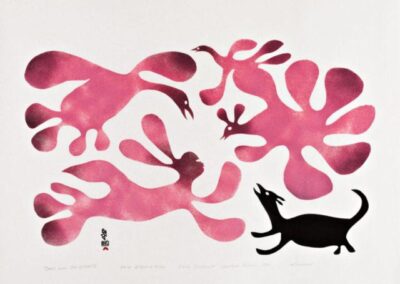Our next Artist You Need To Know is Kenojuak Ashevak (1927 – 2013).
Kenojuak Ashevak | ᕿᓐᓄᐊᔪᐊᖅ ᐋᓯᕙᒃ | Qinnuajuaq Aasivak was a Canadian Inuk artist. Recognized as one of the most significant modern Inuit artists she was also among the leaders of a generation of Arctic artists over the more than five decades of her career. She worked in a variety of media including graphic art, drawings and prints in stone cut, lithography and etching.
”There is no word for art…it is to transfer something from the real to the unreal. I am an owl..a happy owl.’
Ashevak was born in an igloo in an Inuit camp (Ikirasaqa or Ikirasaq) located on the southern coast of Baffin Island in the north to Silaqqi and Ushuakjuk (who was a hunter, fur trader and respected shaman among his people). She was taught traditional skills by her grandmother Koweesa : with her encouragement, Ashevak began carving and drawing in her twenties. Her early life was difficult (her father was murdered) and when she was diagnosed with tuberculosis she was forcibly taken to Parc Savard Hospital (an ‘Indian hospital’ in Quebec City). She was kept there from 1952 to 1955 : Ashevak would move to Kinngait (Cape Dorset) in 1966. Her community – and her own family – was ravaged by disease, and she lost a number of children during her life, as well as many other loved ones. This contrast to the joyful and vibrantly happy nature of her artwork is often remarked upon by art historians.
Ashevak met James and Alma Houston in Kinngait in the 1960s: this would be an important landmark in her life and career, as these two were trying to establish an arts program and Ashevak found great support both conceptually but also through the facilities at the Co Op Art Centre the Houstons created.
From the Inuit Art Foundation : Beginning “in the late 1960s Ashevak quickly gained recognition for her prints and has since become arguably the most renowned Inuit artist in the world. Ashevak worked in carving and drawing but rose to prominence through her graphic works. She portrayed animals, humans and spirits of her surrounding environment, focusing on birds in particular.”
“I just take these things out of my thoughts and out of my imagination, and I don’t really give any weight to the idea of its being an image of something…. I am just concentrating on placing it down on paper in a way that is pleasing to my own eye, whether it has anything to do with subjective reality or not. And that is how I have always tried to make my images, and that is still how I do it, and I haven’t really thought about it any other way than that. That is just my style, and is the way I started and the way I am today.”
From here : “She was the first Inuit artist inducted into Canada’s Walk of Fame (2001), was made an Officer of the Order of Canada (1967) and promoted to Companion in 1982. She received the Governor General’s Award in Visual and Media Arts (2008) and the Order of Nunavut (2012). Her work, with its superb design qualities, was used for Canadian stamps, coins and banknotes. For instance, in 1970, Canada Post placed her 1960 print Enchanted Owl on a stamp to commemorate the centennial of the Northwest Territories and in 2017, the Bank of Canada unveiled a commemorative $10 banknote in honour of Canada’s 150th birthday featuring Ashevak’s print Owl’s Bouquet on the note. She received Honorary Doctorates from Queen’s University (1991) and the University of Toronto (1992).”
Ashevak has exhibited her work in Canada, Europe and Asia. Her artwork can be found in many collections, both in Canada and abroad.
In 1963 Ashevak was the subject of an NFB (National Film Board) documentary titled Eskimo Artist: Kenojuak : it was nominated for an Academy Award for Documentary Short Subject in 1964. The director – John Feeney – had wanted to use the term “Inuit” in place of “Eskimo” but was overruled in an act of institutional racism under the excuse of the ‘unfamiliarity’ of this term to audiences. You can watch that here.
Almost thirty years later (in 1992) she was heavily featured in the film Momentum which was produced for Expo ’92 : that can be seen here.
In 2016, a Heritage Minute was produced by Historica Canada all about Ashevak : it was the first to be narrated in Inuktitut (all previous ones had been in either French or English). Her granddaughter did the narration and it was filmed in Cape Dorset, Nunavut as well.
To mark her birthday in 2014, Google created and showcased a special doodle of her work.
Kenojuak Ashevak died from lung cancer at the age of 85 : her legacy as an inspiration for many Inuit artists that were both her contemporaries and members of a younger generation who looked to her as a groundbreaking pioneer has been clearly recognized. A fine obituary celebrating her importance was published by Canadian Art Magazine here.
More of Ashevak’s artwork can be enjoyed here and there is a wonderful profile of the artist at the Inuit Art Foundation (which lists her many accomplishments and accolades) here.
“This is my job and my love. I cannot imagine life without art.”

